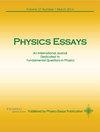中子星事件视界
IF 0.5
Q4 PHYSICS, MULTIDISCIPLINARY
引用次数: 0
摘要
中子可压缩性的新物理证据支持从内部观察者的角度重新评估中子星如何过渡到黑洞。在将观测证据与相对论模型进行比较后,得出的结论是,至少非旋转孤立的黑洞被更好地称为黑恒星,它符合质量越来越大的中子星的连续体,一旦它们超过临界质量,就会变得不可见,如图5所示 M⊙。在这个质量之外,两个事件视界同时发展,分离形成存在于内视界和外视界之间的光子陷阱。这个内部地平线(在表面之下)避免了真正奇点的形成,并且显然 ≤ 6.75 公里半径,而外部地平线 ≥ 6.75 公里半径,确认为史瓦西半径的50%。在广义相对论中,对外部观察者来说显而易见的数学奇点可能是一种幻觉。我们的方法还显示了引力红移如何影响中子星的质量和表面半径。本文章由计算机程序翻译,如有差异,请以英文原文为准。
Neutron star event horizons
New physical evidence of the compressibility of neutrons has supported a reappraisal of how neutron stars transition into black holes, taken from the perspective of an internal observer. After comparing observational evidence with relativistic models, it is concluded that, at least
nonrotating isolated black holes are better termed as black stars, which fit a continuum of increasingly massive neutron stars that become invisible once they exceed a critical mass, suggested as 5 M⊙. Beyond this mass, two event horizons develop concurrently, separating
to form a photon trap that exists between the inner horizon and the outer horizon. This inner horizon (below the surface) avoids the formation of a real singularity and is apparently ≤ 6.75 km radius, while the outer horizon is ≥ 6.75 km radius,
confirmed as 50% of the Schwarzschild radius. The mathematical singularity that is apparent to an external observer in general relativity may be an illusion. Our methodology also shows how gravitational redshift may inform the mass and surface radius of a neutron star.
求助全文
通过发布文献求助,成功后即可免费获取论文全文。
去求助
来源期刊

Physics Essays
PHYSICS, MULTIDISCIPLINARY-
自引率
83.30%
发文量
50
审稿时长
6-12 weeks
期刊介绍:
Physics Essays has been established as an international journal dedicated to theoretical and experimental aspects of fundamental problems in Physics and, generally, to the advancement of basic knowledge of Physics. The Journal’s mandate is to publish rigorous and methodological examinations of past, current, and advanced concepts, methods and results in physics research. Physics Essays dedicates itself to the publication of stimulating exploratory, and original papers in a variety of physics disciplines, such as spectroscopy, quantum mechanics, particle physics, electromagnetic theory, astrophysics, space physics, mathematical methods in physics, plasma physics, philosophical aspects of physics, chemical physics, and relativity.
 求助内容:
求助内容: 应助结果提醒方式:
应助结果提醒方式:


